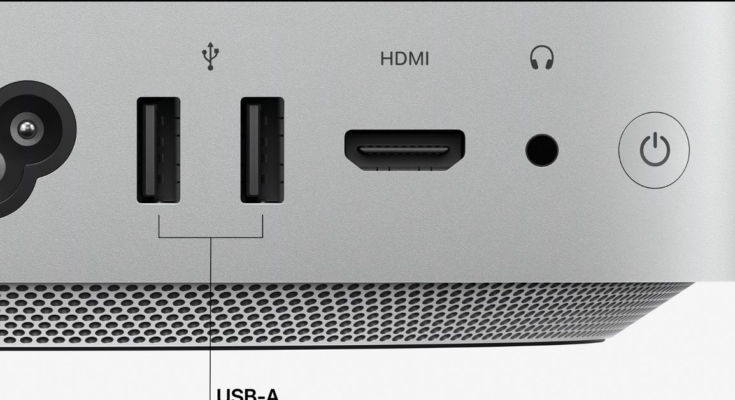Rejoice, peasants! Your proletarian gadgets may live another year yet!
I refer, of course, to the Mac Studio that Apple recently announced, which hits shelves March 18th. The company made a number of lofty claims about the device’s power and efficiency, using various charts that it did not label in any particularly useful way. Those are just claims until we get our hands on a unit — we’ll need to verify the metrics ourselves.
But Apple also showed us pictures of the device. We’ve seen it. And there are two things we know for sure, without a doubt, that it has. Computer, enhance:
:no_upscale()/cdn.vox-cdn.com/uploads/chorus_asset/file/23303744/image__32_.png)
Sure, there are some ports for Thunderbolt, Ethernet, whatever. But look at those two little rectangles to the left of the HDMI. Those two beautiful rectangles.
These, my friends, are a new invention called “USB-A”. I’m told you can use these to connect mice and keyboards to your computer, though I’ve always just used the PS/2 port for that. The plugs only appear to go in one way, which seems like a bit of a design oversight. But overall, I’m excited to see where this standard will take us.
:no_upscale()/cdn.vox-cdn.com/uploads/chorus_asset/file/23298812/lcimg_3cf0d7db_821f_4efb_8c69_29cbe61d1f1a.jpg)
Just kidding. In seriousness, I breathed a legitimate sigh of relief as soon as I saw that picture — I was worried for a minute there that Apple might ship this device without USB-A.
Over the past few years, Apple has been screwing around with the connectivity on some of its MacBook generations. I am typing this as we speak on a 2019 Pro that’s USB-C only and reader, I am sad about it. The latest MacBook Pro models have gotten a number of ports back, but they’re still missing USB-A.
The journey with desktop systems, while not as devastating to me personally, has still been worrisome over the past few years. The 2020 Mac Mini, though it did have two USB-As, was a significant I/O downgrade from previous Mac Mini models. I watched with anxiety as Macs continued shedding ports. Laptops are one thing, I told myself, but surely, surely, Apple would never take USB-A off its desktops.
And then we got the 2021 iMac. USB-C only. And I worried that might be the final straw. If Apple was shipping USB-C-only desktops — I repeat, desktops — maybe we’d never see it again.
:no_upscale()/cdn.vox-cdn.com/uploads/chorus_asset/file/22521218/akrales_20210515_4583_0025.jpg)
So I was quite content to see these images during Apple’s Studio announcement, and if you were following our live blog, you’ll know, I wasn’t the only one.
:no_upscale()/cdn.vox-cdn.com/uploads/chorus_asset/file/23302652/Screen_Shot_2022_03_09_at_7.51.34_PM.png)
:no_upscale()/cdn.vox-cdn.com/uploads/chorus_asset/file/23302653/Screen_Shot_2022_03_09_at_7.51.17_PM.png)
:no_upscale()/cdn.vox-cdn.com/uploads/chorus_asset/file/23302655/Screen_Shot_2022_03_09_at_7.50.29_PM.png)
:no_upscale()/cdn.vox-cdn.com/uploads/chorus_asset/file/23302666/Screen_Shot_2022_03_09_at_7.49.59_PM.png)
Anyway. As my colleague Chaim Gartenberg pointed out recently, there are all kinds of valid reasons to prefer USB-C to USB-A. It’s smaller, it’s reversible, and you can use it to charge. I understand why companies like Apple and Dell want to pressure the industry towards that standard. On the day every good SSD, webcam, mouse, keyboard, and other modern peripheral drops USB-A, I’ll be leading the parade.
On the other hand, speaking as someone who often uses a MacBook Pro and a 2021 iMac as daily drivers, here’s a brief list of the things I cannot connect without a dongle: my mouse (sue me, I don’t like Apple’s mice), my mechanical keyboard, my external webcam, my podcast microphone, my camera, four drives that I keep various things on, and my CD player (yes, I use one occasionally). This is many people’s reality.
And sorry, I’m just going to say it — dongles are damn hard to keep track of. I rely on my tiny USB-C to USB-A adapter for my life, and half the time I don’t even know where it is. The other day I found it under my couch. I could not tell you how it got there.
This isn’t a headphone jack situation where the industry is lining up to follow Apple off the cliff. I’m glad the company has recognized that despite the benefits of USB-C, professionals may still need this port. Multiple of this port, in fact.
I’m just hoping Apple’s consumer products (hello, iMac) follow suit. Because I really think this need still exists in the consumer space too. In fact, this audience may be even more likely to own older peripherals, and less hungry to upgrade them.
So please join me in rejoicing: USB-A is here to stay — at least for now. If you need me, I’ll be campaigning for VGA on the next MacBook Air. Just kidding! (Kind of).



